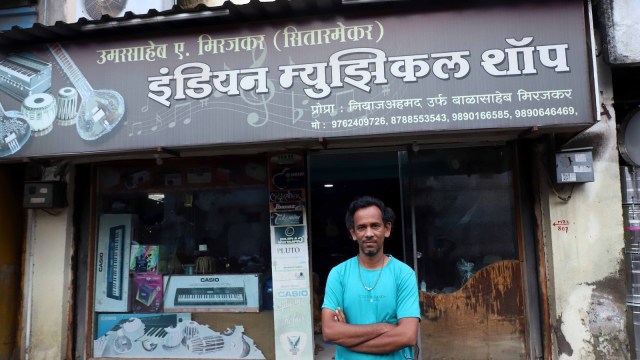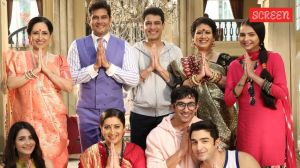Click here to join Express Pune WhatsApp channel and get a curated list of our stories
Melodies in the making: How Miraj’s sitarmakers keep Indian classical music alive
Situated 240 km from Pune, Miraj is a former princely state in Sangli district that has turned into a hub of artisans who create tanpuras, sitars and other string instruments that form the bedrock of Indian classical music.
 Situated 240 km from Pune, Miraj is a former princely state in Sangli district that has turned into a hub of artisans who create string instruments that form the bedrock of Indian classical music. (Express Photo by Pavan Khengre)
Situated 240 km from Pune, Miraj is a former princely state in Sangli district that has turned into a hub of artisans who create string instruments that form the bedrock of Indian classical music. (Express Photo by Pavan Khengre)A thick thrum of traffic emerges from MG Road on Shaniwarpeth in Miraj, its tempo varying when horns blare or a bullock cart passes with a creaking, soulful note. Several times during the day, the excited chatter of a congregation leaving an old mosque adds to the hubbub. Only a discerning ear can pick up an inimitable sound that is weaving through the cacophony being created by string instruments in the hands of craftsmen.
Following the notes leads to some of the greatest – and unknown – masters of Indian classical music, the craftsmen. Though they have been pursued by gurus and doyens of the country for more than 150 years, the artisans of Miraj are missing a spotlight. It was only this year that Miraj took a definitive step to protect its unique heritage with a GI tag, ensuring that its identity is recognised and located according to its geography.
Situated 240 km from Pune, Miraj is a former princely state in Sangli district that has turned into a hub of artisans who create tanpuras, sitars and other string instruments that form the bedrock of Indian classical music. Countless vocalists have begun their musical journeys by matching the first note, ‘sa’, to a tanpura.
Ahmedsahab Aminsaheb Sitarmaker, who lives off a busy street in Miraj, was responsible for giving Gangubai Hangal and Ustad Bade Ghulam Ali Khan their tanpuras and sitars. When Bhisem Joshi mesmerised crowds on stage, the twin sitars accompanying him were crafted by Ahmedsahab. A year short of his 100th birthday, Ahmedsahab’s voice quavers but not his hands.
 Ahmedsahab Aminsaheb Sitarmaker (Express Photo by Pavan Khengre)
Ahmedsahab Aminsaheb Sitarmaker (Express Photo by Pavan Khengre)
On a Friday afternoon, after offering prayers, Ahmedsahab fixes his hearing aid and listens intently to the sitar that he is tuning. His deft fingers pluck at strings, turn knobs and keep adjusting until, satisfied, he looks up. “I have inherited this gharana of making tanpuras and sitars from my forefathers. My son and my grandson are carrying on the legacy. There is a lot of responsibility in what we do. When I was learning the craft from my uncle at the age of 11, if I made the smallest mistake, one heavy slap would fall on me,” he says.
A few minutes’ walk away, next to a shop called Fancy Patakhe that sells firecrackers and animal masks, is the century-old Indian Musical Shop where a group of buyers has come from another city to stock up on equipment. Indian Musical Shop is a glass-fronted showroom that looks different from the workshop it used to be when the present owner, Niyaz Ahmed, better known as Balasaheb Mirajkar, used to come after school to learn the craft from his father. Among the few constants are the raw material, particularly a quantity of dry gourd or tumba that give the instruments their rich music.
“I am the fifth generation, which means that, before me, four generations of my family have been doing this work. My father told me, ‘If you want to make good instruments, you must first have sur ka gyaan (knowledge about notes)’. He put a sitar in my hands. Once I knew 25 ragas, he told me, ‘Now you can start learning to tune,’” says Balasaheb, 65.
Like the guru-shishya style, the new generation of artists sits in front of the teacher and learns through practice. The instruments from here travel to Europe, Japan, Singapore and Australia, among others, where Indians have set up academies to teach classical music.
Instruments of war and music
Miraj has been ruled by the Bhamani empire, the Bijapur Sultanate, the Marathas, the Mughals and the British. It is, however, the 700-year-old dargah of Sufi saint Khwaja Samsuddin Meerasaheb, whose devotees are “90 per cent Hindus, mostly women”, which is the most prominent landmark of the city.
In the 1800s, the kalash on the dome of the dargah needed repairs, for which a group of the best shikalgars or weapon-makers from Bijapur were brought to Miraj. Among them were the brothers Mohinuddin and Faridsaheb, to whom the sitarmaker families of Miraj trace their lineage.
 Mohsin Mirajkar plays the sitar in his ce tury-old shop in Miraj. (Express Photo by Pavan Khengre)
Mohsin Mirajkar plays the sitar in his ce tury-old shop in Miraj. (Express Photo by Pavan Khengre)
Shikalgars were a community that traditionally made weapons of war, such as swords and artillery, for the armies of Bijapur sultan Adil Shah. With the passage of time, wars became more sophisticated and the shikalgars found themselves with little work. A turning point in their history arrived when the Patwardhan family, which ruled Miraj, held a musical soiree with an eminent artiste. The musician’s tanpura malfunctioned and nobody could repair it.
“Shrimant Balasaheb Patwardhan II, the king of Miraj, asked the shikalgars to work on the tanpura. The shikalgars said, ‘We have never worked on musical instruments before but let us see what can be done’. Adept at all kinds of metal and woodwork, the hands that made tools that inflicted death, pain and violence began to focus on melody. The visiting musician was surprised as the repaired tanpura had a better tonal quality than before,” says Mohsin Mirajkar, the sixth generation artisan and son of Balasaheb.
The shikalgars evolved into sitarmakers. Most artistes carry the surnames Sitarmaker and Mirajkar to this day.
The dargah would grace Miraj with yet another musical impetus in the form of Abdul Karim Khan Saheb, considered the father of modern Kirana Gharana. “He came to Miraj after being diagnosed with an incurable disease. Abdul Karim Khan Saheb was cured and spent the rest of his life in Miraj. He taught not only musicians but also the makers of tanpuras and sitars,” says Asgar Sharik Maslat, the priest at the dargah. Among Abdul Karim Khan’s disciples was Sawai Gandharva, whose disciple was Bhimsen Joshi, a beloved vocalist of the sitarmakers of Miraj.
Abdul Karim Khan died in 1937 and rests in the dargah alongside his wife Banubai, their graves decorated with notations of their favourite ragas.
The confluence of artists, from the late Kolkata-based Ustad Rashid Khan to the Pune-based Shrinivas Joshi, and the role of Muslim artisans in Indian classical music, give Miraj a layered social fabric.
The sitarmakers also emphasise that making a sitar or a tanpura is a collective effort. “At least five people are needed. We sit together, each person doing the woodwork, making the dhancha or structure, applying the polish, making designs or tuning. It is one of the reasons that brothers of different generations live together in a joint family. If we go in different ways, how will the work get done?” says Inam ul-Haq, a fourth-generation sitar maker.
Songs of innovation
Miraj was once home to thousands of sitarmakers, of whom only a few dozen families remain. An older generation can point out workshops that are either shuttered or rented out where music used to be made. “Young men prefer to look elsewhere for their careers,” says one sitarmaker. His companion, who is scraping a block of wood, disagrees, “A lot of men have realised that, unlike other industries, there is a lot of work in making musical instruments. We can fulfill only a small percentage of orders we get and that too, not on time. Many people who went away are coming back to this work.”
The sitarmakers say that they don’t need marketing for their business. “We can create 25-30 tanpuras and sitars every month but orders are for 100. We have a long waiting list. The gap in demand and supply had brought in companies who were supplying sitars and tanpuras of dubious quality as Miraj products,” says Mohsin, who is in his forties and was instrumental in applying for the GI tag for the Miraj sitar and tanpura.
Mohsin is growing his hair, Zakir Husain style, and says that he wanted to learn the tabla as a youngster. He is, today, a trained classical vocalist and represents the new generation that is innovating with tradition. He leads the way to a ground floor centre where 20 machines are spread over a 4,000 sq ft space.
Here, 15-20 artisans are using the machines to do the work that, elsewhere, is being accomplished by hand, such as hollowing and shaping wood and carving designs. This is the Miraj Musical Instruments Cluster, the only centre in India that is working towards mechanising tanpura and sitar making, thus standardising the product, but also training future artisans and musicians, including women.
“Cutting a block of wood by hand can take four to five hours while a machine can do it in less than an hour. We can create a tanpura or sitar by a week and thus increase production while ensuring that karigars get a decent wage and the music goes on,” says Mohsin.
One of his successful experiments is kept at his showroom though he will not sell it. It is a sitar whose sound board is ribbed like a Western guitar. “Listen to the tonal quality,” says Mohsin, sitting down to play. “There has been little or no research done on the Miraj tanpura and sitar. We are planning to introduce research to understand how to improve tanpuras. We would also like to experiment with other materials so that string instruments become more affordable and faster to produce. It is our dream to increase the number of Indian classical musicians and vocalists,” he adds. Mohsin begins to play his innovative sitar and, as the rich notes of Raag Charukeshi fills the air, even the traffic outside turns silent.
Click here to join Express Pune WhatsApp channel and get a curated list of our stories













